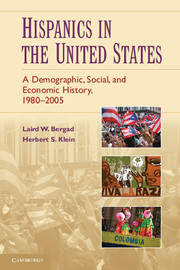Book contents
- Frontmatter
- Contents
- List of Graphs, Tables, and Maps
- Introduction
- 1 Immigration to the United States to 1980
- 2 The Hispanic Population to 1980
- 3 Population Growth and Dispersion, 1980–2005
- 4 The Demography of the Hispanic Population
- 5 Wealth and Poverty
- 6 Educational Attainment
- 7 Citizenship, the Latino Electorate, and Voter Participation
- 8 Occupational Structures, Employment, and Unemployment
- 9 English Language Abilities and Domestic Usage
- 10 Hispanic Business Ownership
- 11 Race
- 12 Endogamous and Exogamous Marriage Patterns among Latino Household Heads
- 13 Conclusion
- Bibliography
- Index
4 - The Demography of the Hispanic Population
Published online by Cambridge University Press: 05 June 2012
- Frontmatter
- Contents
- List of Graphs, Tables, and Maps
- Introduction
- 1 Immigration to the United States to 1980
- 2 The Hispanic Population to 1980
- 3 Population Growth and Dispersion, 1980–2005
- 4 The Demography of the Hispanic Population
- 5 Wealth and Poverty
- 6 Educational Attainment
- 7 Citizenship, the Latino Electorate, and Voter Participation
- 8 Occupational Structures, Employment, and Unemployment
- 9 English Language Abilities and Domestic Usage
- 10 Hispanic Business Ownership
- 11 Race
- 12 Endogamous and Exogamous Marriage Patterns among Latino Household Heads
- 13 Conclusion
- Bibliography
- Index
Summary
Hispanics have had a demographic impact on the United States far beyond their relative importance within the total population because of their high fertility rates. In fact, it is quite clear that the United States would have had below population replacement rates of reproduction in the past few decades had it not been for the contribution of the Hispanic population, and above all Mexicans and Central Americans. When the Center for Disease Control first began enumerating Hispanic births in a systematic way in 1990, their fertility rate was already well above national averages. In that year the total fertility rate (defined as births per hundred women ages 15–44) among Hispanic women was 3.2 children, while the comparable rate for non-Hispanic white women was 1.9 children, a rate that had prevailed since the late 1970s. The rapid growth of the Latino population since 1990, and their consistently higher fertility rates compared with the rest of the population, has resulted in the national population growing naturally at or above a total fertility rate of 2.1 children, which is the threshold for the population replacement level. Without this Hispanic population growth U.S. fertility rates would have resembled those of most European countries, which have fallen below population replacement levels.
Because of their relative weight within the Hispanic population, Mexicans, with a fertility rate of 3.0 children, heavily impacted the overall Latino fertility rate. Most other Latino national subgroups had total fertility rates that approximated the Mexican rates, with the average in 1990 at 2.9 children. Yet there were nationalities that varied considerably from the Mexican norm. The most extreme was the Cubans whose total fertility rate of 1.5 children in 1990 was the lowest for any major Hispanic national subgroup, even below that of non-Hispanic whites. Puerto Ricans had fertility rates that fell between Cubans and Mexicans and were comparable with those of non-Hispanic blacks. In 1990 the Puerto Rican total fertility rate was 2.3 children, and this compared with a rate of 2.5 children among non-Hispanic blacks (see Graph 4.1).
- Type
- Chapter
- Information
- Hispanics in the United StatesA Demographic, Social, and Economic History, 1980–2005, pp. 99 - 122Publisher: Cambridge University PressPrint publication year: 2010



